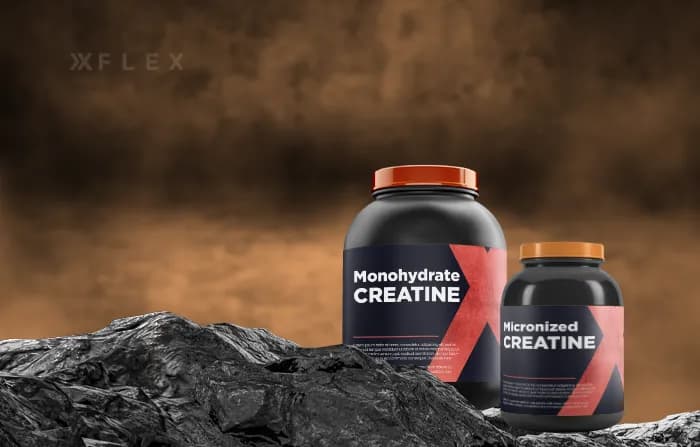Creatine: Monohydrate vs. Micronized
Is monohydrate or micronized creatine better for tough workouts? Read to find out. Plus, more about your body’s natural creatine production, and how it can up your game.
Find out which type of creatine— micronized creatine vs. monohydrate— is best for your toughest workouts.
Creatine is one of the most popular supplements used to help maintain your energy during workouts or lifting exercises.
Naturally produced in the body, you can also get creatine through your food or nutritional supplements. Scientific evidence shows that creatine is strongly linked to improved energy production during exercise.
That being said, if you’re looking to supplement, choosing the right creatine for you can seem like a daunting task. With so many powders, pills, and capsules on the market choosing a creatine product without weeks of trial and error can feel impossible.
Fortunately, we’re breaking down the key differences between two main creatine types: monohydrate creatine and micronized creatine.
This should help you better understand the way these creatine types work within your body and help you make an informed decision on what to look out for when purchasing creatine.
How Does Creatine Work?
Creatine is an amino acid compound. Your body produces it both naturally and in supplement form. It plays an essential role in energy production for high-intensity, short-duration activities where you need to generate a lot of power. Three amino acids make up creatine: arginine, glycine, and methionine.
We’re going to get a little technical here, so feel free to skip this section if you’re not a science lover.
First and foremost, creatine helps regenerate adenosine triphosphate (ATP). Think of it as the main energy currency of your body’s cells. For activities where you need quick energy boosts (weightlifting, sprinting, etc.) your muscles use ATP as fuel.
When ATP breaks down, it becomes adenosine diphosphate (ADP). Creatine helps your body recycle ADP back into ATP. This helps create energy for dynamic muscle movements.
Creatine is produced in your body naturally, but you can also get it through the food you eat. Creatine-rich foods include:
- Red meat
- Dairy
- Seafood

Produced internally in the liver, kidneys, and pancreas, most creatine is then distributed to your skeletal muscles. About 95% of your body’s creatine is stored in the skeletal muscle system, while the remaining 5% is stored in your brain.
Benefits of Creatine
Creatine can provide a number of benefits to the body. These include:
- Better strength and power: For resistance training and explosive movement, creatine is linked to better power output.
- More muscle mass: When combined with adequate muscle training, there is evidence to show that creatine helps improve muscle mass. Creatine helps to attract water to the muscle fibres as well. Although too much water retention can lead to bloating, keeping your muscles hydrated helps with dehydration which athletes are often up against. There is some evidence that this muscle hydration could help creatine users perform better in high-heat situations and less optimal weather conditions because of its effects on hydration.
- Quicker recovery: Some studies have reported that creatine can benefit recovery time after stints of intense exercise.
- Cognition: It’s not only for your muscles. Creatine has some potential positive effects on cognitive processes. Taking oral creatine supplements can benefit short-term memory. There are also some links between creatine and reasoning ability in healthy populations.
Creatine may also offer some other benfits as well. To learn more, you can read Does Creatine Help with Weight Loss, Can You Mix Creatine with Protein Powder, and Can I Take Creatine Before Bed.
Creatine Supplement Studies
Creatine is one of the better-researched athletic performance supplements in the medical community, especially creatine monohydrate. According to a report from the American College of Sports Medicine, short-term creatine use is considered safe for athletic performance.
Researchers still need to perform more studies on long-term creatine use to determine its safety.
Several studies have shown that mixing strength and resistance training with creatine supplementation supports athletic performance and building fat-free muscle.
Despite this, there is less medical consensus on creatine dosing for athletic performance or maintenance use.
Some creatine users like to take a “loading dose” before introducing creatine into their regular supplement regime. This loading phase involved taking a larger dose of about 20-25 grams of creatine 4-5 times daily for up to a week. After this, users can taper back to around 4-5 grams once a day.

What is Creatine Used For?
It’s common to take creatine in supplement form, but your body produces it naturally as well! This amino acid helps send energy to your muscles and improve muscle mass. Creatine can also be beneficial for brain health.
How do athletes use creatine? Creatine supplements are some of the most common performance supplements athletes use. Creatine is especially useful for exercises that require explosive power, like sprints, or heavy weightlifting.
Generally, athletes can receive a quick power boost from creatine that helps quick movement, while not sacrificing their endurance skills. This makes creatine a fantastic essential for many high-intensity sports.
What Are the Differences Between Creatine Monohydrate vs. Micronized Creatine?
How is monohydrate creatine different from micronized creatine? They’re not all that different chemically speaking — manufacturers make micronized creatine from creatine monohydrate broken down into smaller particles.
You may be wondering why producers of creatine would want to mess with the original. After all, the athletic supplement market has offered traditional monohydrate creatine for many years and retailers sell it the most often.
The answer is that micronized creatine has far smaller particles. We can produce micronized creatine at 20 times smaller particle sizes than its monohydrate cousin. This makes micronized creatine more water-soluble, easily digestible and simpler to mix.
You can take creatine monohydrate as a pill, capsule or powder supplement. Micronized creatine is only available in powder form, though.
Creatine Monohydrate — Pros
Price
Monohydrate creatine is generally cheaper than micronized since it requires less effort to produce.
Reputation
Monohydrate creatine has a more scientific reputation than micronized creatine. Although technically, the micronized version is the same just in smaller particles, newer creatine users may feel more comfortable using products that have a tried and true reputation.
Creatine Monohydrate — Cons
Stomach Problems
Because of its larger particle size, creatine in a monohydrate form can cause people with highly sensitive stomachs to experience some discomfort. The big particles can create bloating, diarrhea, or stomachaches.
Monohydrate creatine supplements can be especially risky if you order from the first company you see online. Due to their larger particle size, it’s easier for creatine producers that are less reputable to disguise impurities in these types of creatine products, compared with the fine powder used in micronized creatine. Make sure you’re properly vetting all consumable products and buying from reputable sellers who know what they’re doing.
Micronized Creatine —Pros
Texture
Because micronized creatine has a finer texture than monohydrate, some users find it smoother or easier to consume. If you dislike power that clumps and has an unpleasant texture, micronized creatine may be for you. Since the particles are so fine, it’s easier to maintain a smooth texture with micronized creatine.
Efficiency
Because of its small particle size, some users claim micronized creatine is easier for your body to digest and distribute throughout your muscles. Since there has not been as much study on micronized creatine as on monohydrate, there is not enough evidence yet to make a conclusion here.
Creatine Monohydrate — Cons
Price
Micronized creatine is generally more expensive to buy than creatine monohydrate. You may want to do some market research if you’re leaning toward a micronized creatine product to make sure you’re getting the best value.
Limited Available Forms
Micronized creatine is generally only available in a powder format, vs. monohydrate, which is available in capsules or pills as well as powder. For users who don’t like taking powdered supplements, this could be a deterring factor from trying micronized creatine.
Which Creatine is the Best?
Ultimately, choosing between monohydrate and micronized creatine is a matter of preference. The particle sizes in each type— smaller for micronized and larger for monohydrate— may inform your preference.
If you’re looking for a super mixable powder that absorbs quickly, choose the micronized version. To get more bang for your buck, monohydrate creatine may be preferable for you. If you’re considering creatine supplements as part of your regime, it’s a good idea to talk to a doctor or registered dietitian to make sure your product of choice is safe and aligns with your fitness goals.

Are you a creatine newbie? Maybe you’ve got a bit of experience but want to keep a record of how your favorite creatine products fuel your workouts.
Lucky for you, Flex AI offers an all-in-one workout platform to help you learn new exercises, visualize your fitness journey and keep all your fitness faves in one place. We’ve made it simple to work on customized fitness plans or to introduce a little friendly competition to your fitness community by sharing exercises with your friends. Get started for free through the Flex fitness app.
To learn more about other supplements you can consider, here are a few helpful reference points:
Related articles
Does Creatine Help With Weight Loss
How Is Protein Powder Made? Whey, Casein and Vegan Proteins
Supplement Snapshot: Can Protein Powder Go Bad?


Get fit with Flex
Build muscle & lose weight fast for free.
Available on iPhone + Apple Watch





